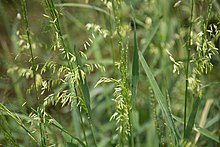Zizania texana
| Zizania texana | |
|---|---|
 |
|
| Scientific classification | |
| Kingdom: | Plantae |
| Clade: | Angiosperms |
| Clade: | Monocots |
| Clade: | Commelinids |
| Order: | Poales |
| Family: | Poaceae |
| Genus: | Zizania |
| Species: | Z. texana |
| Binomial name | |
|
Zizania texana Hitchc. |
|
Zizania texana is a rare species of grass known by the common name Texas wild rice. It is endemic to Texas, where it is found only on the upper San Marcos River in Hays County. It is threatened by the loss and degradation of its habitat. It is a federally listed endangered species of the United States.
This grass, a member of the same family as commercially sold wild rice, is an aquatic plant that grows in the water with only its stem tips rising above the surface. It grows 1 to 2 meters long but the stems have been known to reach five meters in length. The ribbon-like leaves are up to a meter in length. The inflorescence is a panicle up to 31 centimeters long by 10 wide. The male spikelet is somewhat oval in shape and the female is lance-shaped with a long awn which may be a few centimeters in length. The male and female flowers are on different branches of the panicle. Pollen is carried to other plants on the wind. The plant can grow by cloning and sometimes forms mats of cloned stems.
This plant is limited to a single site on the first two miles of the San Marcos River in Texas. There are 140 clumps of stems in this population. It covers about 1200 square meters. There is also an introduced population at Spring Lake at the San Marcos Springs and a number of specimens are kept in an enclosure on the Texas State University campus. The natural habitat of the grass is the clear water of the San Marcos River, which is fed by springs originating in the Edwards Aquifer. The grass occurs in a relatively narrow range of water conditions, including temperature, pH, and turbidity, flow rates, and substrate types.
This plant was once locally common in the area, growing thick enough to become a nuisance as recently as the 1930s. It has been reduced to its rare status because the Edwards Aquifer has been drained of its water for use in agriculture and other industries, lowering the flow on San Marcos River. The rare plant is threatened now by recreational activities on the river, and by nutria, an introduced mammal. Stems are broken, bent, or submerged by floating debris, including masses of vegetation mowed upstream and sent floating.
...
Wikipedia

